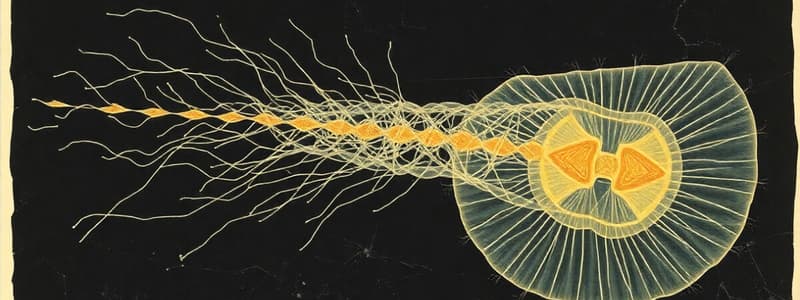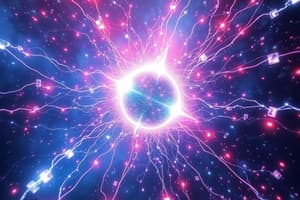Podcast
Questions and Answers
Which of the following is a distinguishing feature of Entamoeba histolytica?
Which of the following is a distinguishing feature of Entamoeba histolytica?
- Contains bacteria in food vacuoles (correct)
- Has a regular distribution of chromatin granules
- Lacks a cystic wall (correct)
- Contains RBCs in food vacuoles
Entamoeba coli has a cystic wall.
Entamoeba coli has a cystic wall.
True (A)
Name one of the four species of Plasmodium that causes malaria in humans.
Name one of the four species of Plasmodium that causes malaria in humans.
Plasmodium vivax
The infective stage of Entamoeba histolytica is known as the ______.
The infective stage of Entamoeba histolytica is known as the ______.
Match the following stages of Plasmodium sp. life cycle with their descriptions:
Match the following stages of Plasmodium sp. life cycle with their descriptions:
Which structure helps Apicomplexa parasites penetrate their host?
Which structure helps Apicomplexa parasites penetrate their host?
Plasmodium sp. is solely transmitted through contaminated water.
Plasmodium sp. is solely transmitted through contaminated water.
The __________ are intracellular blood parasites of birds and mammals that cause malaria in humans.
The __________ are intracellular blood parasites of birds and mammals that cause malaria in humans.
Which of the following is NOT a type of habitat for Sarcodina protozoans?
Which of the following is NOT a type of habitat for Sarcodina protozoans?
Amoeba generally lives in low-oxygen environments.
Amoeba generally lives in low-oxygen environments.
What is the function of pseudopodia in amoeba?
What is the function of pseudopodia in amoeba?
Entamoeba histolytica is classified as a __________ endoparasite.
Entamoeba histolytica is classified as a __________ endoparasite.
Match the following amoebae with their characteristics:
Match the following amoebae with their characteristics:
Which of the following statements about Entamoeba coli is true?
Which of the following statements about Entamoeba coli is true?
The ectoplasm and endoplasm of Entamoeba histolytica are well differentiated.
The ectoplasm and endoplasm of Entamoeba histolytica are well differentiated.
Amoeboid movement in amoeba is caused by changes in the colloidal protoplasm from a fluid '_________' to a solid 'gel' condition.
Amoeboid movement in amoeba is caused by changes in the colloidal protoplasm from a fluid '_________' to a solid 'gel' condition.
Flashcards
Sarcodina (Amoebozoa)
Sarcodina (Amoebozoa)
Protozoans with a thin membrane, no defined shape, and use pseudopodia for movement and feeding.
Amoeba proteus
Amoeba proteus
A free-living Sarcodina found in freshwater habitats. It uses contractile vacuoles for water regulation and temporary pseudopodia for movement and feeding.
Amoeboid movement
Amoeboid movement
The movement of Amoeba proteus where the cytoplasm changes from a fluid to a solid state to move and extend pseudopodia.
Parasitic Amoebae
Parasitic Amoebae
Signup and view all the flashcards
Entamoeba coli
Entamoeba coli
Signup and view all the flashcards
Entamoeba histolytica
Entamoeba histolytica
Signup and view all the flashcards
Entamoeba gingivalis
Entamoeba gingivalis
Signup and view all the flashcards
Apicomplexa
Apicomplexa
Signup and view all the flashcards
Plasmodium sp.
Plasmodium sp.
Signup and view all the flashcards
Life Cycle of Plasmodium sp.
Life Cycle of Plasmodium sp.
Signup and view all the flashcards
Exerythrocytic Cycle
Exerythrocytic Cycle
Signup and view all the flashcards
Erythrocytic Cycle
Erythrocytic Cycle
Signup and view all the flashcards
Mosquito Stage
Mosquito Stage
Signup and view all the flashcards
Plasmodium sp. Transmission
Plasmodium sp. Transmission
Signup and view all the flashcards
Malaria
Malaria
Signup and view all the flashcards
Malaria Prevention and Treatment
Malaria Prevention and Treatment
Signup and view all the flashcards
Study Notes
Sarcodina (Amoebozoa)
- Sarcodina are protozoans with a thin protoplasmic membrane and no defined shape
- They move and feed using pseudopodia
- Sarcodina can be free-living, commensal or parasitic
- Amoeba proteus is an example of a free-living Sarcodina
- Amoeba proteus lives in well-oxygenated freshwater habitats, often on decaying vegetation
Amoeba proteus
- Amoeba proteus uses contractile vacuoles to regulate water through osmosis
- Amoeba proteus uses temporary pseudopodia to move and capture food
- Amoeba proteus exhibits amoeboid movement, a process where the colloidal protoplasm transitions from a fluid state ("sol") to a more solid state ("gel")
Parasitic Amoebae
- There are six genera of parasitic amoebae
- These parasites live in the intestinal tract (five genera) and the buccal cavity (one genus)
Entamoeba coli
- Entamoeba coli is an intestinal commensal
- Entamoeba coli feeds on bacteria
Entamoeba histolytica
- Entamoeba histolytica is an intestinal parasite
- Entamoeba histolytica feeds on tissues and blood of the host
- Entamoeba histolytica can cause amoebic dysentery
Entamoeba gingivalis
- Entamoeba gingivalis is a buccal commensal
Comparing Entamoeba histolytica and Entamoeba coli
- Entamoeba coli lives in the lumen of the large intestine, while Entamoeba histolytica lives in the wall of the large intestine
- The ectoplasm and endoplasm are not clearly differentiated in Entamoeba coli, but are well differentiated in Entamoeba histolytica
- Entamoeba coli has two pseudopodia, while Entamoeba histolytica has a large single pseudopodium
- The karyosome in Entamoeba coli is lateral, while the karyosome in Entamoeba histolytica is central
- Entamoeba coli has irregularly distributed chromatin granules, while Entamoeba histolytica has regularly distributed chromatin granules
- Entamoeba coli food vacuoles contain bacteria, while Entamoeba histolytica food vacuoles contain red blood cells (RBCs)
- Entamoeba coli precysts can be round or oviod in shape
- Entamoeba coli precysts lack a cystic wall
- Entamoeba coli cysts contain glycogen and rod-shaped chromatoid bodies, while Entamoeba histolytica cysts contain glycogen but lack chromatoid bodies
- Entamoeba coli mature cysts have 8 nuclei, while Entamoeba histolytica cysts have 4 nuclei
Phylum Apicomplexa
- Apicomplexa are protozoan parasites that are endoparasites in higher animals
- They are intracellular blood parasites found in blood cells and tissues of birds and mammals
- Apicomplexa cause a variety of diseases
- Apicomplexa are transmitted by blood-sucking arthropods which act as intermediate hosts
Plasmodium sp.
- There are four species of Plasmodium that infect humans
- Each species is responsible for a different type of malaria
- The four species are:
- Plasmodium vivax
- Plasmodium malariae
- Plasmodium ovale
- Plasmodium falciparum
- Each species infects red blood cells (erythrocytes) in humans
- Plasmodium can also infect white blood cells (leukocytes)
Life Cycle of Plasmodium sp.
- The life cycle of Plasmodium sp. is divided into three phases:
- Exerythrocytic cycle (Liver stage)
- Erythrocytic cycle (Human blood stage)
- Mosquito stage
Exerythrocytic Cycle
- The exerythrocytic cycle takes place in the liver of humans
- The cycle starts as a sporozoite injected by the mosquito
- The sporozoite develops into a merozoite, which then infects red blood cells (erythrocytes)
Erythrocytic Cycle
- The merozoite multiplies rapidly in red blood cells by schizogony
- This creates a new generation of merozoites that are then released into the bloodstream
- These merozoites can infect other red blood cells, repeating the cycle and causing malaria symptoms
Mosquito Stage
- Mosquitoes become infected by consuming human erythrocytes containing merozoites
- Within the mosquito, the merozoites develop into gametocytes
- Gametocytes then fuse together to form zygotes
- The zygotes undergoes sporozoite formation, creating sporozoites which are then injected into humans by the mosquito
- The sporozoites then infect the liver, restarting the exerythrocytic cycle
Plasmodium sp. Transmission
- The final host of Plasmodium is the female Anopheles mosquito
- Humans are the intermediate host
Malaria
- Malaria is caused by parasites of the genus Plasmodium that are transmitted by infected female Anopheles mosquitoes
- Malaria is a serious illness that can be fatal
- Symptoms include fever, chills, sweating, headache, muscle aches, and fatigue
- Malaria is preventable and treatable
Studying That Suits You
Use AI to generate personalized quizzes and flashcards to suit your learning preferences.




